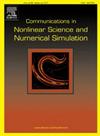A new pathway for controlling absence seizures by reducing GABA uptake from astrocytes: a dynamical perspective
IF 3.8
2区 数学
Q1 MATHEMATICS, APPLIED
Communications in Nonlinear Science and Numerical Simulation
Pub Date : 2025-05-01
DOI:10.1016/j.cnsns.2025.108929
引用次数: 0
Abstract
Modeling studies associated with absence epilepsy often consider neural circuits and neglect the critical involvement of glial cells. Recently, the view that astrocytes are new targets for the treatment of epilepsy has received increasing attention. Based on the established basal ganglia-corticothalamic (BGCT) mean-field model involving glutamate (GLU) dynamics in the extracellular space of cerebral cortex, by introducing γ-aminobutyric acid (GABA) dynamical processes, we further extend the model and explore the effectiveness of inhibiting the GABA uptake from cortical astrocytes (Vgai) in controlling seizures induced by different triggers. The results show that reducing Vgai can control seizures to a certain extent, regardless of the neural triggers with two types of abnormal feedforward inhibition or the astrocytic triggers with insufficient glutamate uptake from astrocytes. Although no uniform conclusions are achieved by comparing the above measure for the control of seizures caused by different triggers, it is worth noting that the setting of the initial condition greatly affects the control rate of spike wave discharges (SWDs). Appropriate selection of initial values can make reducing GABA uptake from astrocytes more effective in eliminating SWDs. Our results provide a theoretical basis for the treatment of epilepsy by targeting astrocytes from a dynamical perspective.
通过减少星形胶质细胞对GABA的摄取来控制失神发作的新途径:一个动力学的观点
与缺失性癫痫相关的模型研究通常考虑神经回路,而忽略了神经胶质细胞的关键参与。近年来,星形胶质细胞作为治疗癫痫的新靶点的观点越来越受到关注。在已建立的涉及大脑皮层胞外空间谷氨酸(GLU)动力学的基底神经节-皮质丘脑(BGCT)平均场模型的基础上,通过引入γ-氨基丁酸(GABA)动力学过程,进一步扩展该模型,探讨抑制皮质星形胶质细胞(Vgai)摄取GABA在控制不同触发因素诱发的癫痫发作中的有效性。结果表明,无论是两种前馈抑制异常的神经触发,还是星形胶质细胞谷氨酸摄取不足的星形胶质细胞触发,降低Vgai均能在一定程度上控制癫痫发作。虽然通过比较上述措施对不同触发因素引起的癫痫发作的控制并没有得出统一的结论,但值得注意的是,初始条件的设置对尖峰波放电(SWDs)的控制率有很大影响。适当选择初始值可以使减少星形胶质细胞对GABA的摄取更有效地消除SWDs。本研究结果从动力学角度为星形胶质细胞靶向治疗癫痫提供了理论依据。
本文章由计算机程序翻译,如有差异,请以英文原文为准。
求助全文
约1分钟内获得全文
求助全文
来源期刊

Communications in Nonlinear Science and Numerical Simulation
MATHEMATICS, APPLIED-MATHEMATICS, INTERDISCIPLINARY APPLICATIONS
CiteScore
6.80
自引率
7.70%
发文量
378
审稿时长
78 days
期刊介绍:
The journal publishes original research findings on experimental observation, mathematical modeling, theoretical analysis and numerical simulation, for more accurate description, better prediction or novel application, of nonlinear phenomena in science and engineering. It offers a venue for researchers to make rapid exchange of ideas and techniques in nonlinear science and complexity.
The submission of manuscripts with cross-disciplinary approaches in nonlinear science and complexity is particularly encouraged.
Topics of interest:
Nonlinear differential or delay equations, Lie group analysis and asymptotic methods, Discontinuous systems, Fractals, Fractional calculus and dynamics, Nonlinear effects in quantum mechanics, Nonlinear stochastic processes, Experimental nonlinear science, Time-series and signal analysis, Computational methods and simulations in nonlinear science and engineering, Control of dynamical systems, Synchronization, Lyapunov analysis, High-dimensional chaos and turbulence, Chaos in Hamiltonian systems, Integrable systems and solitons, Collective behavior in many-body systems, Biological physics and networks, Nonlinear mechanical systems, Complex systems and complexity.
No length limitation for contributions is set, but only concisely written manuscripts are published. Brief papers are published on the basis of Rapid Communications. Discussions of previously published papers are welcome.
 求助内容:
求助内容: 应助结果提醒方式:
应助结果提醒方式:


